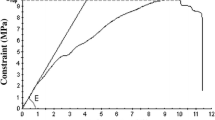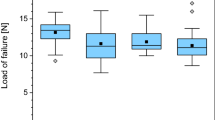Abstract
Lyophilized allograft musculoskeletal tissue is generally intended to be stored at “ambient” or “room” temperature, and usually is kept in climate controlled indoor storage areas. However, there is a question of what temperature extremes tissue may see, especially during transportation, in that these extremes may exceed even the limits of “ambient” conditions. Temperatures may become quite hot, but only for a few hours and only during daytime. Damage from high temperatures, if it occurs, is expected to be evident by damage to the collagen component of bone, soft tissue, and demineralized bone, as well as to the growth factors contained in demineralized bone. If damage is significant, then temperature monitoring requirements for lyophilized allograft tissue might be necessary. To answer this question, a literature review was carried out to look at the short-term temperature resistance of collagen and demineralized bone. Both collagen and the growth factors in demineralized bone show remarkable short term tolerance to elevated temperatures in the dry state, and it was concluded that temperature excursions of 50°C or less, lasting for a few days or less, would not cause any significant deterioration. This means that temperature monitoring also should not be required.
Similar content being viewed by others
Abbreviations
- DBM:
-
Demineralized bone
References
Arnoczky SP, Aksan AA (2000) Thermal modification of connective tissues: basic science considerations and clinical implications. J Am Acad Orthop Surg 8(5):305–313
Bailey AJ (1968) The nature of collagen. Comp Biochem 26B:297–423
Bailey AJ, Sims TJ, Avery NC, Miles CA (1993) Chemistry of collagen cross-links, glucose mediated covalent cross-linking of type IV collagen in lens capsules. Biochem J 296:489–496
Bailey AJ, Paul RG, Knott L (1998) Mechanisms of maturation and aging of collagen. In: Mechanisms of aging and development, Elsevier Science, Ireland, pp 1–56
Bischof JC, He X (2005) Thermal stability of proteins. Ann NY Acad Sci 1066:12–33
Borchers RE, Gibson LJ, Burchardt H, Hayes WC (1995) Effects of selected thermal variables on the mechanical properties of trabecular bone. Biomaterials 16(7): 545–551
Burjanadze TV (1982) Evidence for the role of 4-hydroxyproline localized in the third position of the triplet (Gly–X–Y). In: Adaptational changes of thermostability of a collagen molecule and collagen fibrils. Biopolymers 21:1489–1501
Cotliar AM et al (1985) Examer laser radical keratomy. Opthalmology 92:206–208
Finch A, Ledward DA (1972) Shrinkage of collagen fibers. Biochem Biophys Acta 278:433–439
Flory PJ, Garrett RR (1958) Phase transition in collagen and gelatin systems. J Am Chem Soc 80:4836–4845
Han B, Yang Z, Nimni M (2005) Effects of moisture on the osteoinductivity of demineralized bone matrix. J Ortho Res 23:855–861
Komsa-Penkova R, Koynova R, Kostov G, Tenchov B (1999) Discrete reduction of type I collagen thermal stability upon oxidation. Biophysical Chem 83:185–195
Kronick PL, Cooke P (1996) Thermal stabilization of collagen fibers by calcification. Connect Tissue Res 33(4):275–282
Kumudinie C, Premachandra JK (1999) Collagen. In: Polymer data handbook, Oxford University Press, pp 70–77
Laitinen M, Kivikari R, Hirn M (2006) Lipid oxidation may reduce the quality of a fresh-frozen bone allograft. Is the approved storage temperature too high. Acta Orthop 77(3):418–421
Leuscher M, Eueeg M, Schindler P (1974) Effect of hydration upon the thermal stability of tropocollagen and its dependence on the presence of neutral salts. Biopolymers 13(12):2489–2503
Martin GJ Jr, Boden SD, Titus L, Scarborough NL (1999) New formulations of demineralized bone matrix as a more effective graft alternative in experimental posterolateral lumbar spine athrodesis. Spine 24(7):637–645
Miles CA (1993) Kinetics of collagen degradation in mammalian lens capsules studied by differential scanning calorimetry. Int J Macromol 15:265–271
Miles CA, Burjanadze TV (2001) Thermal stability of collagen fibers in ethylene glycol. Biophys J 80:1480–1486
Miles CA, Ghelashvili M (1999) Polymer-in-a box mechanism for the thermal stabilization of collagen in fibers. Biophys J 76:3243–3252
Miles CA, Burjanadze TV, Bailey AJ (1995) The kinetics of the thermal denaturation of collagen in unrestrained rat tail tendon determined by differential scanning calorimetry. J Mol Biol 245:437–446
Miles CA, Avery NC, Rodin VC, Bailey AJ (2005) The increase in denaturation temperature following cross-linking of collagen is caused by dehydration of the fibers. J Mol Biol 346:551–556
Nakanishi K, Sato K, Sato T, Takahashi M, Fukaya N, Miura T (1992) Preservation of bone morphogenetic protein in heat-treated bone. Nippon Seikeigeka Gakkai Zasshi 66(9):949–955
Ohta H, Wakitani S, Tensho K, Horiuchi H, Wakabayashi S, Saito N, Nakamura Y, Nozaki K, Imai Y, Takota K (2005) The effects of heat on the biological activity of recombinant human bone morphogenetic protein-2. J Bone Miner Metab 23(6):420–425
Rich A, Crick FH (1961) The molecular structure of collagen. J Mol Biol 3:483–506
Sand BJ (1994) Method for collagen shrinkage. US Patent 5,304,169
Sato T, Iwata H, Takahashi M, Miura T (1993) Heat tolerance of activity toward ectopic bone formation by rabbit bone matrix protein. Ann Chir Gynaecol Suppl 207: 37–40
Sekiya JK, Golladay GI, Wojtys EM (2000) Autodigestion of a hamstring anterior cruciate ligament autograft following thermal shrinkage. J Bone Joint Surg 82-A(110):1454–1457
Snowden JM, Etre DR, Swann DA (1982) Age related changes in the thermal stability and crosslinks of vitreous, articular cartilage and tendon collagens. Biochemica et Biophysica Acta 706:153–157
Spears et al (1990) Corneal refractive correction by laser thermal keratoplasty. SPIE, vol 1202 Laser-Tissue Interaction
Urist MR, Iwara H, Ceccotti PL, Dorfman RL, Boyd SD, McDowell RM, Chien C (1973) Bone morphogenesis in implants of insoluble bone gelatin. Proc Nat Acad Sci USA 70(12) Part I: 3511–3515
Wall MS, Deng XH, Torzilli PA, Doty SB, O’Brien SJ, Warren RF (1999) Thermal modification of collagen. J Shoulder Elbow Surg 8:339–344
Zoricic S, Bobinac D, Lah B, Maric I, Cvijanovic O, Bajek S, Golubovic V, Mihelic R (2002) Study of the healing process after transplantation of pasteurized bone grafts in rabbits. Acta Med Okayama 56(3):121–128
Acknowledgements
This work was sponsored by the AATB (American Association of Tissue Banks). STAC (Scientific and Technical Affairs Committee) Assistance in reviewing the manuscript was provided by John Bianchi, PhD; Revivicor, Inc. 1700 Kraft Drive, Suite 2400, Blacksburg, VA 24060.
Author information
Authors and Affiliations
Corresponding author
Rights and permissions
About this article
Cite this article
Shimp, L. Heat resistance of allograft tissue. Cell Tissue Bank 9, 259–266 (2008). https://doi.org/10.1007/s10561-008-9066-3
Received:
Accepted:
Published:
Issue Date:
DOI: https://doi.org/10.1007/s10561-008-9066-3




